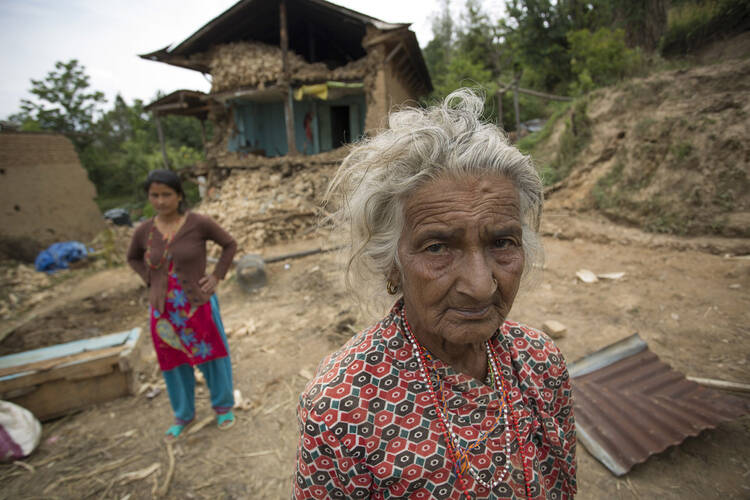We had a chance to “speak” via e-mail this morning with Jennifer Hardy, a regional information officer for Catholic Relief Services. Jen has been in Nepal tracking the agency’s effort to respond to the 7.8 richter earthquake which hit Nepal on April 25. Jen says she’s in “lack of sleep” and “totally dirty emergency response mode,” but took some time from her important work to give us an update on the effort so far to respond to a disaster which killed more than 8,400 and has left hundreds of thousands without homes :
What are some of the conditions you are seeing?
I’m in Gorkha, which is located between Pokhara and Kathmandu. Gorkha town itself looks ok, with some buildings damaged but very few collapsed. The earthquake has caused big problems with the water supply, so we only have intermittent running water. In more rural areas in the district, where C.R.S. is working, it’s a different story. Some houses are fully collapsed, others have walls blown out and still others that look intact on the outside are actually full of rubble and debris on the inside. I’ve walked up to homes that look ok on the outside, only to peek in the door and see the floor more than halfway covered with brick or stones from collapsed interior walls. These homes are totally uninhabitable and must be rebuilt from the ground up.
What are some concerns as the disaster response continues?
Nepal goes through a strong monsoon season every year from June-September. During these months of intense daily rains, moving construction materials and relief goods anywhere except for along the main paved roads will be very difficult or impossible. That’s why we are working so fast to give families the materials they need right away—we know they need to make their emergency shelters as strong as possible as quickly as possible to make the rains more bearable.
The reason delivery of goods will be so challenging is that the dirt roads will turn to slick mud when it rains. Right now it’s a very fine powdery dust, but as soon as it starts raining that powdery dust will turn into a quagmire. It’s pretty difficult to deliver goods with such fine dust swirling around us. Our Caritas Nepal colleagues jokingly call it “Nepal powder,” as in a type of face powder because at the end of the day our skin is caked with dust.
What are people telling you about their experience of the quake? How they are surviving?
People have been sharing similar stories of being confused and surprised, running out of their houses and turning around and seeing walls buckle and roofs fall. They talk about how they spent the first night or two in the cold and rain. And now, they worry constantly about the coming monsoon. They know they won’t be able to rebuild before the big rains start in a few weeks, so they worry how they will wash clothes and have them dry in the rain, how they will keep their food and animals dry, what will begin to mold, and other worries. Of course, for families that lost a loved one, all of those worries about the future are compounded by grief and loss.
What are the greatest needs you’re seeing?
Every family I’ve interviewed reports that shelter is their number one concern. Some report difficulty with affording food, but there are no food shortages in the markets. It’s just a matter of helping families bridge the period from the earthquake until they can harvest their corn in about four months time. Since the biggest need is shelter, that’s where C.R.S. will focus our long-term recovery efforts, after the immediate emergency relief phase wraps up.
How has coordination been with government and other humanitarian relief? Are supplies getting through to areas outside the capital?
Coordination between government officials and other humanitarian agencies—especially our sister Caritas agencies around the world—has been good. The real problem is the scale of this disaster, the vast geography it covers and the difficult access into small mountain towns. Supplies are moving but of course we are doing everything we can to move them faster. We know families are in great need and we only have a small window to distribute goods before the rains begin.
What is the state of the people you are encountering? And C.R.S. staff, how are they holding up?
Our staff are so inspiring. They are working incredibly long days in very difficult conditions, yet they still cheer and clap when we get updated numbers on families we’ve reached or word that new supplies have crossed the border from India.
The people we are helping are experiencing trauma in different ways. Those who have lost a loved one are struggling the most, but everyone is coping with grief of lost homes and possessions and worry about the future.
Any projections on recovery? How and what is needed?
C.R.S. has committed $10 million to the emergency response and recovery. Our sister Caritas agencies will contribute additional resources to the recovery effort. Central Nepal has taken a big economic hit and recovery will be a matter of years, not months, especially in rebuilding people’s homes to be stronger in the event of a future earthquake.
The U.S. bishops have issued an appeal for donations. Do people in Nepal know that people outside want to help them? Does it give them any comfort?
I asked one man, Bal Bahadur Rana, age 75, where he found hope or strength to keep face each day with so many difficulties and so much suffering. He lost his granddaughter and his home in the earthquake. He replied that he found strength in visits and aid provided by groups like C.R.S., because he felt like he wasn’t forgotten. That maybe something good would happen tomorrow if something good happened today.








